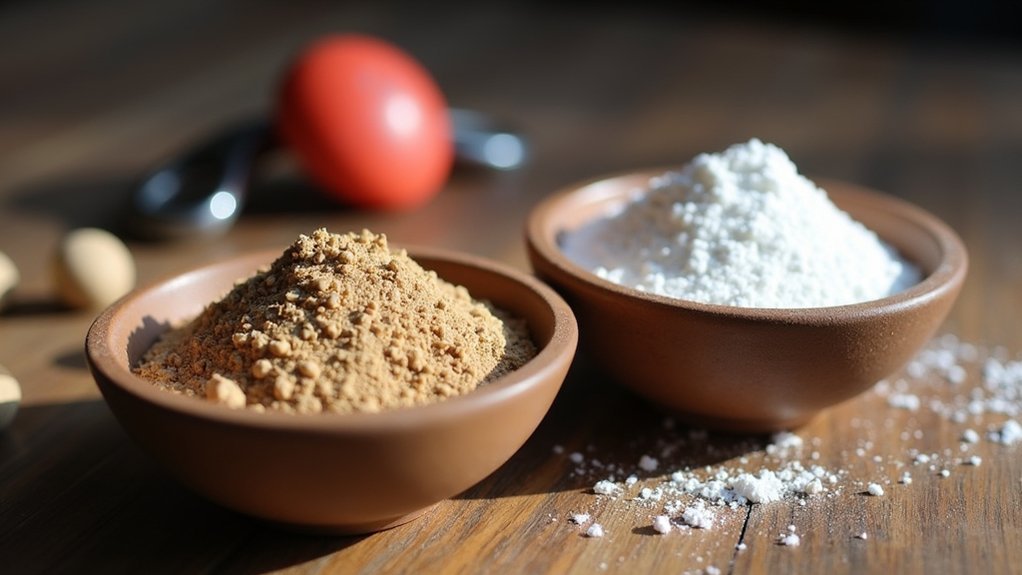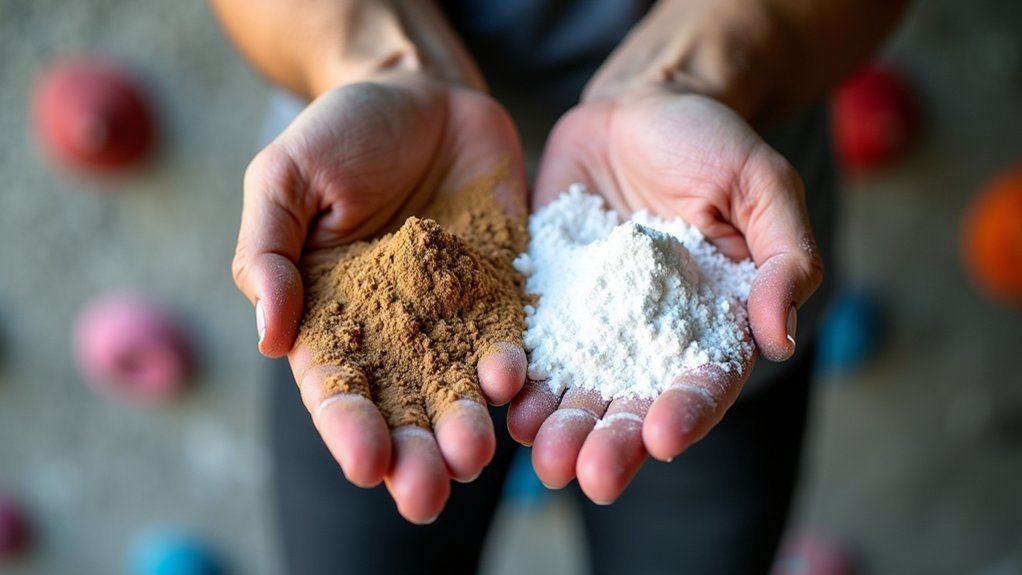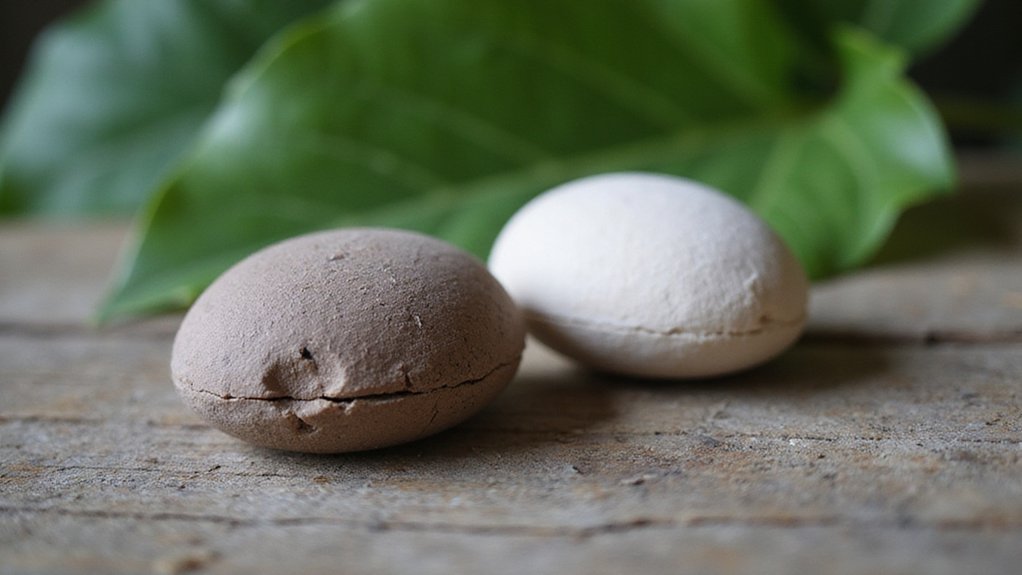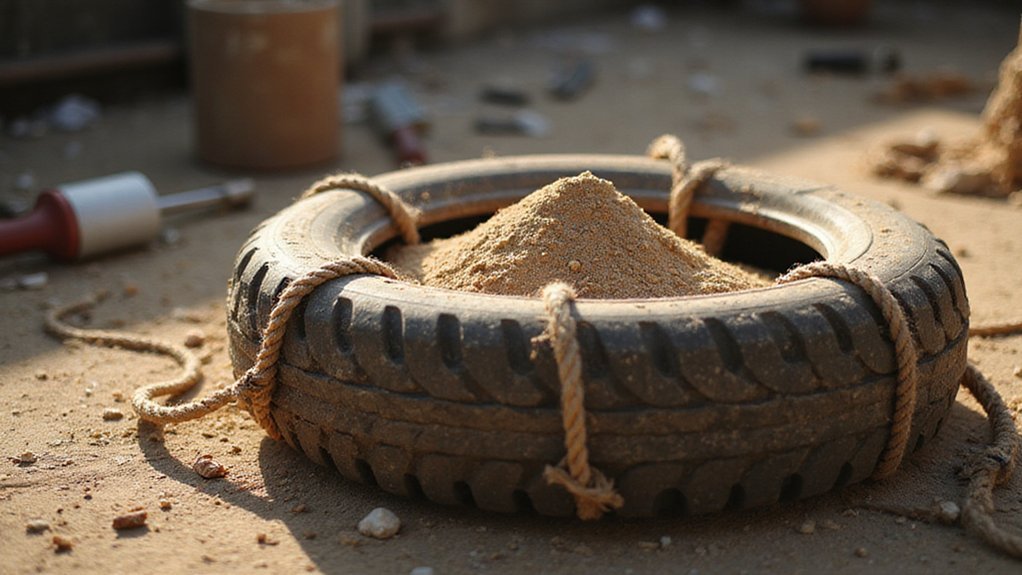Disclaimer: This content is for informational purposes only and does not replace professional medical advice, diagnosis, or treatment. Always consult a qualified healthcare provider before beginning any new exercise program.
You might not realize that climbers are rewriting their grip strategy with unconventional chalk materials. Traditional magnesium carbonate isn’t the only game in town anymore. Walnut shell chalk is emerging as a sustainable alternative that challenges performance expectations. Its biodegradable composition offers environmental benefits, but can it truly match the moisture-wicking properties of standard climbing chalk? The science behind friction, grip, and ecological impact is more complex than you’d imagine. What compromises are you willing to make for sustainability?
Key Takeaways
- Walnut shell chalk offers a biodegradable alternative to traditional magnesium carbonate climbing chalk, reducing environmental impact from mining and waste.
- Magnesium carbonate provides superior moisture absorption and grip performance, making it more effective for high-intensity climbing compared to walnut shell alternatives.
- Eco-conscious climbers can balance performance needs by choosing hybrid chalk blends that combine walnut shell powder with conventional chalk materials.
- Walnut shell chalk produces less dust, minimizes environmental disturbance, and supports sustainable climbing practices with its agricultural byproduct composition.
- While walnut shell chalk may not completely replace magnesium carbonate, it represents a promising step towards developing more environmentally friendly climbing gear solutions.
The Science Behind Climbing Chalk Materials

While climbing enthusiasts seek ideal grip performance, the scientific composition of chalk plays a critical role in athletic success. Magnesium Carbonate (MgCO₃) dominates the climbing chalk market due to its superior moisture absorption and grip-enhancing properties. Its insoluble nature transforms when exposed to moisture, creating hydrated compounds that improve athletic grip. Particle size critically influences chalk’s effectiveness, with finer particles delivering more thorough coverage and better absorbency.
Eco-friendly alternatives like walnut shell powder are emerging, offering biodegradable options that address environmental impact concerns. Though less absorbent than traditional Magnesium Carbonate, these sustainable chalk variations provide climbers an opportunity to reduce their ecological footprint while maintaining functional grip performance. Understanding the scientific nuances of climbing chalk materials empowers athletes to make informed, environmentally conscious choices.
Performance Comparison: Walnut Shell vs. Magnesium Carbonate

Building upon the scientific foundations of climbing chalk materials, athletes now confront a comparative analysis between traditional Magnesium Carbonate (MgCO₃) and emerging walnut shell alternatives. When selecting chalk for climbing, you’ll find MgCO₃ outperforms walnut shell chalk in essential performance metrics, particularly moisture absorption and grip maintenance. For climbers with sweaty hands, MgCO₃ provides superior dryness and longer-lasting friction, vital during intense activities.
Walnut shell chalk offers an eco-friendly alternative, derived from renewable resources, but compromises performance. Its coarser texture and reduced moisture absorption limit effectiveness in high-intensity scenarios. While suitable for casual climbing, it can’t match MgCO₃’s precision and grip reliability. Your choice depends on balancing environmental considerations with technical performance requirements in climbing environments.
Environmental Impact and Sustainability

Because environmental sustainability has become increasingly critical in outdoor sports, climbers are now scrutinizing the ecological footprint of their chalk choices with unprecedented rigor. Magnesium Carbonate mining presents significant environmental challenges, including habitat destruction and water contamination. In contrast, eco-friendly chalk alternatives like walnut shell-based products offer a more sustainable solution.
| Chalk Type | Environmental Impact | Moisture Absorption |
|---|---|---|
| MgCO₃ | High ecological damage | Standard performance |
| Walnut Shell | Minimal environmental disruption | Comparable effectiveness |
| Synthetic | Reduced mining impact | Engineered properties |
| Agricultural Byproduct | Waste material repurposing | Efficient absorption |
Practical Applications for Climbers

As climbers seek sustainable gear solutions, walnut shell chalk emerges as a practical alternative that balances environmental consciousness with performance requirements. When evaluating its application for rock climbing, consider these strategic considerations:
- Terrain suitability: Ideal for dry climbing environments where moisture control is less critical compared to magnesium carbonate.
- Dust management: Reduced chalk dust production enhances visibility and minimizes environmental disturbance in indoor and outdoor settings.
- Hand performance: Provides moderate grip maintenance while keeping hands dry, though with slightly less effectiveness than traditional chalk.
- Ecological impact: Supports climbers’ commitment to reducing plastic waste and utilizing biodegradable materials.
While walnut shell chalk doesn’t entirely replace conventional magnesium carbonate, it represents a thoughtful compromise between performance and environmental considerations for environmentally conscious climbers.
Emerging Trends in Eco-Friendly Chalk Development

While environmental sustainability drives innovation in climbing gear, eco-friendly chalk development represents a critical intersection of athletic performance and ecological responsibility. Brands are now pioneering walnut shell chalk as a biodegradable alternative to traditional magnesium carbonate, focusing on sustainable production methods that minimize environmental impact.
Emerging research demonstrates that walnut shell chalk can match conventional chalk’s moisture absorption and grip characteristics. These developments signal a significant shift towards environmentally conscious climbing equipment. Manufacturers are experimenting with hybrid blends that combine walnut shell and magnesium carbonate, strategically balancing performance with ecological considerations.
This trend reflects climbers’ growing demand for gear that doesn’t compromise technical effectiveness while reducing environmental footprint. The evolution of eco-friendly chalk represents a sophisticated response to sustainability challenges in sports equipment manufacturing.
Frequently Asked Questions
Is Magnesium Chalk Safe?
You’ll find magnesium chalk safe for most uses, with minimal health risks. Its non-toxic nature and low allergenicity make it a reliable choice for athletes, though you should avoid excessive dust inhalation during application.
Are Chalk and Magnesium the Same?
You’ll find chalk and magnesium aren’t identical: chalk’s MgCO₃ composition differs from pure magnesium. While related, they serve distinct purposes in climbing, with chalk’s moisture-absorption properties and magnesium’s elemental characteristics uniquely impacting performance.
Is Chalk Calcium Carbonate or Magnesium Carbonate?
You’ll find climbing chalk is primarily Magnesium Carbonate (MgCO₃), not Calcium Carbonate (CaCO₃). Its superior mineral properties, absorption capabilities, and production quality make it the preferred chalk composition for athletic usage and performance applications.
Is Liquid Chalk Better for the Environment?
Like a green leaf filtering pollution, you’ll find liquid chalk’s sustainability shines through reduced dust, minimized waste, and eco-friendly production processes. It’s a smart consumer choice that addresses environmental impact while maintaining climbing performance.
Conclusion
As you grip the rock face, the chalk on your hands becomes more than a performance tool—it’s a statement. The convergence of sustainability and climbing performance mirrors your own journey: balancing precision with ecological consciousness. Walnut shell chalk isn’t just an alternative; it’s a symbol of your evolving approach. Whether you’re scaling granite or reducing environmental impact, your choice of chalk reflects a broader commitment to responsible adventure.



